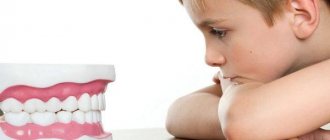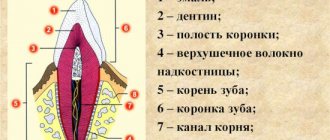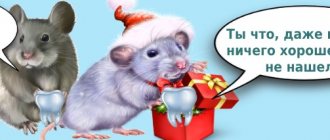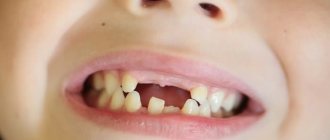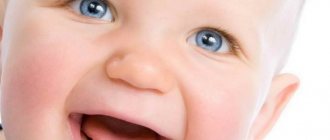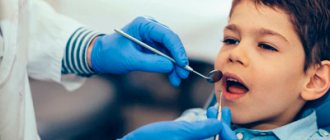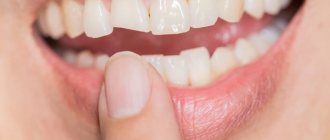Anatomy of permanent teeth
Each molar consists of certain parts:
- crown. This is the part of the tooth that protrudes from the top;
- the root, it goes deep into the alveoli. At the same time, it is attached thanks to special connective tissue bundles. There can be different numbers of roots (1-5 pieces). This moment affects the number of nerves and channels;
- neck. This part is located between the root and the crown.
Tooth tissues are distinguished by their heterogeneity. The enamel is on top and is known for its durability. Once the tooth has erupted, it is covered with a transparent thin layer. This is the cuticle, which eventually changes to the pellicle. The latter is a film that is created from what saliva produces.
Beneath the enamel is dentin, the tissue of the tooth. Dentin is similar to bone when you study how it is built. However, it is more durable because there is a high level of mineralization. In the area where the root is located, the dental tissue is covered with cement. The latter is rich in mineral compounds and is also associated with periodontium. Collagen fibers are used for this.
As for the part of the tooth that is inside, this is the crown and root canal. They are filled with pulp. This is loose connective tissue; it contains nerve endings and blood vessels.
Differences between baby teeth and permanent teeth
Permanent and temporary teeth are built in the same way, but still have certain differences between themselves:
- The enamel on baby teeth is whiter. And the enamel on permanent teeth has a yellowish tint;
- the best indicators of density and mineralization are noted behind the molars;
- the pulp of a baby tooth is large in size, and the dense tissues and their walls are thinner;
- permanent teeth are larger in size, here the length is greater than the width;
- The root of baby teeth is short and thin compared to permanent teeth. When the root of temporary teeth is formed, they expand in width. Therefore, the permanent bud has free space to grow.
The health of baby teeth is the path to the safety of primary teeth
Many parents make the mistake of not monitoring the condition of their child's baby teeth. The logic here is quite simple - if they gradually fall out anyway, then why treat? This is a very dangerous misconception.
If caries, periodontal disease and other oral diseases are not treated, you may encounter serious problems with your molars. Among them are abnormal development, enamel damage, inflammation and much more.
We recommend visiting your dentist regularly for preventive examinations. In this case, it may also be necessary to treat caries if such a lesion has begun.
Where do teeth come from?
Teeth begin to form and develop when the fetus is still inside the womb (at about 6 weeks). They have their source - the epithelial dental plate. Already by 14 weeks, active formation of dental tissues, which are hard, occurs. Initially, this occurs in the area where the crown will be, and later at the root.
Molars, namely their first rudiments, appear by the 5th month of the embryo. They are located higher than the child’s baby teeth or lower. By the time the child is born, the rudiments are already practically formed in the tissues of the jaw.
Teeth that belong to an additional group (have no predecessors) are formed later. This occurs after about 1 year of life. Why? Because the baby's jaw is still very small and there is not enough space for them.
Recommendations for caring for a child's molars
Children's molars require careful care. Young enamel is sensitive to the external environment and bacteria that cause caries. Therefore, it is important to use hygiene products.
The best prevention is to teach your child to maintain good oral hygiene before a permanent bite has formed. To keep your teeth healthy, you need to follow a few simple steps:
- brush your teeth every day ☑️. Brush at least twice a day, use dental floss and mouthwash.
- correct diet ☑️. Sweet plaque on teeth is the best food for bacteria. After meals with a lot of carbohydrates, brush your teeth or rinse your mouth. Avoid snacking when you can't take care of your teeth.
- regular preventive examinations ☑️. You need to visit the dentist once every six months. Treat teeth immediately when problems are detected.
- strengthen teeth ☑️. Eat a balanced diet, take vitamin and mineral complexes rich in calcium.
- Visit the dentist regularly ☑️ and have your teeth professionally cleaned.
Taking care of your teeth doesn't take much time, but taking simple steps now will help you maintain beautiful, healthy teeth for life.
What does a dental formula look like?
To make it more convenient to describe teeth and their number, special formulas are usually used. Each tooth has its own number, which is used to decipher its location.
When describing a milk bite, Roman numerals are used:
- incisors – I, II;
- canine – III;
- molars – IV, V.
If we talk about the formula for adult teeth, here the teeth are counted starting from the center:
- incisors – 1.2;
- fang – 3;
- molars (small) – 4.5;
- molars (large) – 6,7,8.
8 is a wisdom tooth; not every person has it.
What to do when children are teething?
The most natural and one of the most reliable ways to reduce pain is cold. Pick up an item - a “rodent” that can be put in the refrigerator. Freezing them is not recommended because it can damage the baby's delicate gums.
Often children prefer to gnaw on their parent's finger or, unfortunately, on their mother's breast. But parents may not have enough patience for a long time, so it is better to find a suitable teether.
It should be:
- whole and durable (the child should not bite off pieces that could cause choking);
- without ropes and beads (the rope can pinch the neck or break, creating a risk of choking on a bead);
- without paint with toxic components;
- just clean (no need to disinfect it).
You can refrigerate the fruit puree or put a few wet cloth toys in the refrigerator so you can replace them.
Of course, children chew not only objects that are ideal for this. But if with a teether made of one piece of silicone or a mitten with a silicone pad the child can be left alone in the playpen for some time, then with a bunch of small objects on a string around the neck or a bracelet made of beads, the same as with some fruit or vegetable, you need to look after it.
If cooling does not help, and the stress of teething is very severe, discuss taking pain relievers and fever reducers (ibuprofen is most often used) with your pediatrician. To be on the safe side, consult your doctor, but a single dose by weight (for ibuprofen is 10 mg/kg), given once at night for 3-4 days of active teething, will not cause harm.
Teething order
Typically, all children start teething at about the same time. Teeth emerge from the molar set at the age of 5, and it is the molars (large ones) that emerge. Then the diagram is as follows:
- Initially, the incisors on the lower jaw change, which are located in the center;
- then the central incisors appear on the upper jaw and the incisors on the sides on the lower jaw;
- at about 8-9 years old, the incisors on the top and sides change;
- up to 12 years of age, molars (small) grow;
- at the age of 13, the fangs change;
- after the child turns 14 years old, the second molars (large ones) come in. They were not included in the milk kit;
- and after another 1 year the third molars (large) appear. This is a wisdom tooth. But he may not appear at all.
Timing and order of teething
No specialist can say with accuracy what time babies start teething. However, it is generally accepted that the first lower central incisors should appear when the baby is 6 months old. All 20 baby teeth should be in the mouth by the age of 3 years.
It also happens that children’s upper teeth come in first and they appear much later than 6 months. This process is not considered by experts as a deviation from the norm, because teeth begin to erupt from the gums in the sequence in which they were laid during the prenatal period.
Thus, dentists do not recommend focusing attention on which teeth come out first in a child. Despite this, the following scheme for the appearance of incisors in children is generally accepted; parents can partially rely on it if they wish:
- The central ones erupt first, and only then the lateral lower and upper incisors;
- molars, canines and second molars erupt next;
- predominantly the lower teeth appear first, and then the upper ones;
- The appearance of incisors in pairs is often observed; two pairs may even erupt at once.
A common phenomenon is when teeth come out in the wrong order. What to do in such a situation? It is advisable to contact a pediatric dentist to rule out abnormalities. The fact is that deviations in the timing and sequence of teething in children can be caused by the following reasons:
- calcium deficiency and the development of rickets;
- thyroid diseases;
- dysfunction of the digestive system;
- absence of incisors in the gums.
As a rule, there is no cause for concern if the child is under one year old and has no teeth.
How to determine that a child will soon have molars?
There are certain signs that indicate that permanent teeth will soon begin to erupt:
- The spaces between the teeth increase. The jaw grows and the free space increases;
- baby teeth become loose as the root gradually dissolves. It cannot be firmly fixed in the jaw tissues;
- in case of loss of a temporary tooth. This confirms that the molar will soon come out as it has pushed out the previous one;
- The gums are slightly swollen and red.
When permanent teeth erupt, the child’s general well-being usually remains the same, the temperature does not rise, and there is no pain.
What is milk bite? Formula
The appearance of baby teeth is a signal that the baby is growing up. From the point of view of human development, their appearance indicates the following:
- The child is ready for the transition from sucking to chewing, that is, from mother’s milk (or formula) to complementary foods and a gradual transition to normal food.
- From the intuitive production of individual sounds, the baby moves on to understanding speech addressed to him and even tries to imitate it.
The rudiments of baby teeth are formed in the womb, so the woman’s condition during the first trimester of pregnancy is responsible for the predisposition to “bad teeth”.
How many baby teeth should children have? The temporary bite has 20 teeth, of which 8 are incisors, 4 canines and 8 molars.
In dentistry, there are several ways to designate a temporary occlusion. In ordinary life, this information is unlikely to be useful to the mother, but it can help to better understand the dentist’s explanations and actions during the appointment.
- The classical Zsigmond-Palmer system, which was adopted for a long time in the USSR. In it, the milk row was designated with Roman numerals.
- A modern system accepted throughout the world, including by the International Dental Association. It involves using two numbers to designate each tooth. The first number indicates the quadrant in which the tooth is located (upper left or lower right), and the second number indicates the serial number of the tooth itself.
- An alphanumeric system in which each type of baby tooth is designated by a capital letter, and the index number is a serial number. This method is very convenient to indicate a changeable bite. To do this, you just need to replace lowercase letters with capital ones. This change is immediately noticeable.
- In America, it is customary to designate baby teeth using the letters of the English alphabet, placing them from the upper right molar to the lower right.
- You can also find the group designation of milk occlusion. In it, the number indicates the number of teeth of a certain group, and its location, in fact, the type of tooth.
- Similarly, temporary occlusion can be recorded using an alphanumeric system.
How does the jaw of baby teeth differ from permanent teeth?
There is an opinion among parents that baby teeth grow without roots. This myth appeared because during a change in bite, teeth fall out with reduced (resolved) roots. In fact, baby teeth have roots, and their number completely corresponds to that of permanent teeth. Despite the fact that the teeth of the temporary and permanent dentition are similar in appearance, there are several differences between them that help dentists accurately determine the group affiliation of the tooth.
| Milk bite | Permanent bite | |
| Number of teeth | 20 | 32 |
| Premolars | No | There is |
| Color | White-blue | Yellowish |
| Size | Small | Big |
| Crown sizes | The crown is wider than it is tall | High crown |
| Crown to root size ratio | The crown is more convex, making the roots appear smaller | Traditional ratio of crown to root sizes. |
| Presence of enamel roller | In the area of the neck of the tooth there is a thickening of the enamel, due to which the crown becomes larger. | No |
| Degree of mineralization | Low | High |
| Cavity dimensions | Extensive | Standard sizes |
| Channels | Wide canals and apical foramina | Narrow, sometimes difficult to pass with irregularly shaped branches |
| Root shape | Rounded | Long and elongated |
| Direction of root growth | Moved to the side to make room for the permanent tooth germ | Perpendicular to the jaw bone |
| Root reduction | Eat before changing bite | No |
| Tremas and diastemas (distance between teeth) | Normal physiological state as the jaw grows (from 4 to 6 years) | It shouldn't be normal. |
| Lumps and cutting edges | By the time the bite changes, they are erased (by 6 years) | Well expressed throughout life |
Possible problems
Permanent teeth have just appeared, but this does not mean that there will not immediately be any problems associated with them. Parents should be aware of possible dental problems:
- lack of molars;
- pain in the molar area;
- crooked position of molars;
- molars fall out;
- injuries.
For any of these problems, it is important to contact a specialist in time to receive qualified help.

